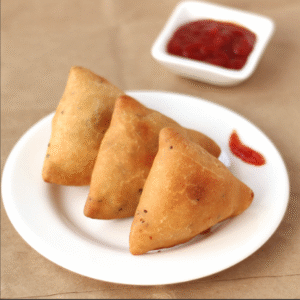A samosa is a popular deep-fried pastry snack originating from the Middle East and South Asia, now enjoyed around the world. It typically has a crispy, golden-brown outer shell made from refined flour (maida), and a savory filling, most commonly spiced potatoes, peas, and onions. However, variations can include minced meat, lentils, or cheese.
Shaped like a triangle or cone, the samosa is known for its crunchy texture and spicy, flavorful interior. It’s often served with tangy tamarind chutney, mint chutney, or yogurt.
Samosas are enjoyed as street food, appetizers, or festive snacks, especially during tea time or Ramadan, and are a beloved part of Indian, Pakistani, Bangladeshi, and East African cuisines, among others.
The samosa is a beloved snack with a rich history that spans continents and centuries. Here’s an overview of its origins and evolution:

Origins in the Middle East
The earliest known references to the samosa date back to the 10th century in the Middle East. It was known by various names, including sanbusak, sanbusaq, and sanbosag, all deriving from the Persian word sanbosag . These early versions were typically baked and filled with meat, nuts, and spices.
Notable mentions include:
-
Ishaq al-Mawsili, an Abbasid-era poet, praised the sanbusaj in the 10th century.
-
Abolfazl Beyhaqi, an Iranian historian, described the dish in his work Tarikh-e Beyhaghi in the 11th century.
-
Ibn Battuta, a 14th-century Moroccan traveler, noted the dish in the court of Muhammad bin Tughluq, referring to it as sambusak .
These references highlight the samosa’s popularity among travelers and royalty alike, appreciated for its portability and rich flavors.
🇮🇳 Introduction to the Indian Subcontinent
The samosa made its way to the Indian subcontinent between the 13th and 14th centuries. Middle Eastern and Central Asian chefs introduced the dish to the royal kitchens of the Delhi Sultanate. Notably, Amir Khusro, a 13th-century scholar and poet, mentioned samosas made of meat, ghee, and onions enjoyed by the nobility .
Over time, the samosa evolved to cater to local tastes. The introduction of the potato to the Indian subcontinent in the 17th century led to the creation of the aloo samosa, a vegetarian variant that became widely popular .
Global Spread and Variations
As Indian cuisine spread globally, so did the samosa. Today, it is enjoyed in various forms worldwide:
-
Africa: In East Africa, it’s known as sambusa, often filled with spiced meat or vegetables.
-
Southeast Asia: In Indonesia and Malaysia, it’s called samosa and filled with ingredients like potatoes, noodles, or cheese.
-
Western Countries: In the UK, USA, and Canada, samosas are popular as a snack or appetizer, often found in Indian restaurants and supermarkets.
Each region has adapted the samosa to local ingredients and tastes, resulting in a delightful array of variations.
Conclusion
From its origins as a Middle Eastern pastry to its status as a global snack, the samosa’s journey reflects centuries of cultural exchange and culinary evolution. Its enduring popularity is a testament to its versatility and the universal appeal of its flavors.
If you’re interested in exploring regional variations or trying your hand at making samosas at home, feel free to ask for recipes or tips!
Ingredients
For the Dough:
-
1½ cups all-purpose flour (maida)
-
4 tbsp oil or ghee
-
½ tsp carom seeds (ajwain)
-
½ tsp salt
-
Water, as needed
For the Filling:
-
4 medium-sized potatoes, boiled and mashed
-
½ cup boiled green peas
-
1 tbsp oil
-
1 tsp cumin seeds
-
1 tsp finely chopped ginger
-
2-3 green chilies, finely chopped
-
1 tsp coriander powder
-
½ tsp cumin powder
-
½ tsp garam masala
-
½ tsp amchur (dry mango powder) or lemon juice
-
Salt to taste
-
2 tbsp chopped fresh coriander leaves
For Frying:
-
Oil, for deep frying
Instructions
1. Prepare the Dough:
-
In a mixing bowl, combine the flour, carom seeds, and salt.
-
Add oil or ghee and rub it into the flour mixture until it resembles breadcrumbs.
-
Gradually add water to form a stiff dough.
-
Cover the dough with a damp cloth and let it rest for 30 minutes
2. Prepare the Filling:
-
Heat oil in a pan over medium heat.
-
Add cumin seeds and let them splutter.
-
Add chopped ginger and green chilies; sauté for a minute.
-
Add the boiled potatoes and peas.
-
Sprinkle in the coriander powder, cumin powder, garam masala, amchur (or lemon juice), and salt.
-
Mix well and cook for 2-3 minutes.
-
Remove from heat and stir in chopped coriander leaves.
-
Let the filling cool to room temperature.
3. Shape the Samosas:
-
Divide the dough into equal portions and roll each into a ball.
-
Roll out each ball into a thin oval or circle (about 6 inches in diameter).
-
Cut the circle in half to form two semi-circles.
-
Form a cone by folding a semi-circle in half.
-
Seal the edge with a little water.
-
Fill the cone with the prepared filling.
-
Seal the open edge, pinching the sides together to form a triangular shape.
4. Fry the Samosas:
-
Heat oil in a deep frying pan over medium heat.
-
Once the oil is hot, gently slide the prepared samosas into the oil.
-
Fry in batches, turning occasionally, until they are golden brown and crisp.
-
Remove the samosas and drain on paper towels.
5. Serve: Serve hot with green chutney or tamarind chutney..
